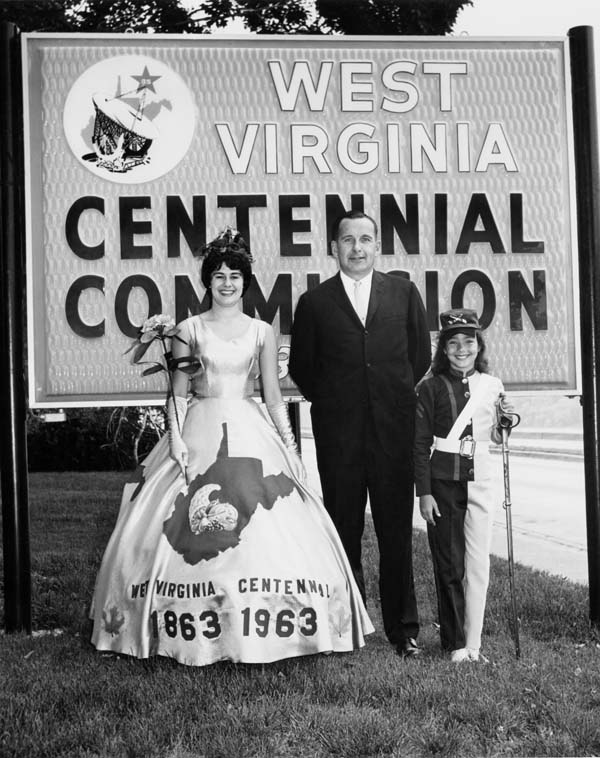Recalling the Centennial
West Virginia at 100
By John Lilly
Photographs courtesy of the West Virginia State Archives

State Centennial Commission director Carl Sullivan stands in front of the Centennial Commission office sign along Kanawha Boulevard in Charleston with Miss West Virginia 1963 (Nina Lu Denton, of Marmet) and Little Miss Century (Cheryl Cardi, of Belle). Photograph by Ethel H. Bennett.
June 20, 1963, dawned gray and wet. A crowd gathered nonetheless at the West Virginia State Capitol in Charleston, anticipating the culmination of what surely was the largest and most exhaustive civic movement in the state’s history – the celebration of the 100th anniversary of the birth of West Virginia.
Virtually everyone in the state had been touched in one way or another by this mammoth centennial effort. Since 1955, organizers had been planning and coordinating activities in all 55 counties, encompassing virtually every aspect of public life. There was a Historical and Research Committee, a Distinguished Guests Committee, a Coronation Ball Committee, a Religious Participation Committee, a Folklore Committee, a Tourism and Recreation Committee, a Sports Committee, an Oil and Gas Committee, an Educational Institutions Committee, and many, many others. Each committee was responsible for a set of activities designed to mark and celebrate West Virginia’s admission to the Union as the 35th state.
Born of rebellion, West Virginia had split from Virginia over matters related to the Civil War. The circumstances of that birth were bitter and controversial, and remain a topic of conversation among historians to this day. After Virginia voted to secede from the Union on May 23, 1861, representatives from the western counties formed a Restored Government of Virginia in June of that year. They approved the formation of a new state - initially called Kanawha, later changed to West Virginia - on May 13, 1862. The creation of the new state was approved by the U.S. Senate on July 14, 1862, and signed into law by President Abraham Lincoln on April 20, 1863, effective 60 days later. On June 20, 1863, it became official.
As the state approached the century mark, elected officials and state leaders saw this as an opportunity to not only affirm the past, but to rally the citizens around some lofty goals for the future as well as attract outside visitors and commerce. These goals were:
- Increase pride in the state, its accomplishments and opportunities, traditions, and history among its own citizens, with particular emphasis on young people and the nation as a whole, with the resultant objective of encouraging West Virginia youngsters to remain in their native state and attracting new industries and enterprises;
- Attract favorable attention and attendance to the state's tourism and recreational facilities;
- Combat the fairly prevalent national impression that West Virginia is a backward, impoverished state largely populated by "hillbillies";
- Reduce sectionalism and create a climate of mutual understanding between rural and urban areas, the State Capital and other communities, and the varied groups and interests that constitute the state's citizenry;
- Dramatize the state's problems frankly and honestly in a manner calculated to mobilize state and private agencies' and organizations' efforts toward a successful solution of such problems and deficiencies;
- Create a centennial program that encourages virtually every citizen to participate actively in and/or attend one or more centennial events; and
- Achieve a maximum amount of favorable publicity in the national, regional, and state press and other communications media, and thus promote the interests of the state and stimulate maximum attendance at centennial events.
Seeing to this rather daunting list of objectives became the charge of the West Virginia Centennial Commission, ultimately chaired by executive director Carl R. Sullivan.
Assistant director Lloyd P. Calvert, of Charleston, now a retired banker, was then a 24-year-old Marshall University graduate with a bachelor’s degree in chemistry and zoology. After an unsuccessful foray into dentistry school in Morgantown at WVU, Lloyd came back to Charleston and accepted a voluntary position in the office of Governor Wally Barron, assisting with travel planning for bus and tour groups visiting the state.
“I got a call from Governor Barron,” Lloyd recalls. “He said he would like me to come by the mansion one day for lunch and talk to me about something. So I went. I was a little bit shaky, 24 years old and having lunch at the governor’s mansion with the governor and his wife and no one else. He wanted to appoint me the assistant director of the State Centennial Commission. That was a great, wonderful feeling! [It was] a tremendous opportunity and turned out to set the direction of my life and professional career, because it brought me more into marketing and more into public relations.”
Lloyd’s job, along with public relations director Mary Sonis, was to coordinate the work of the various state and county committees and ensure that they were making progress toward the commission’s objectives.
You can read the rest of this article in this issue of Goldenseal, available in bookstores, libraries or direct from Goldenseal.